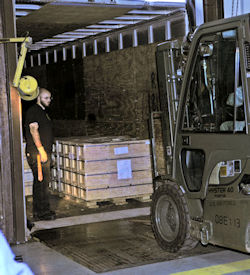Dockboards
The employer must ensure that:
- Dockboards are capable of supporting the maximum intended load;
- Dockboards put into initial service on or after January 17, 2017 are designed, constructed, and maintained to prevent transfer vehicles from running off the dockboard edge;
- Exception: When the employer demonstrates there is no hazard of transfer vehicles running off the dockboard edge, the employer may use dockboards that do not have run-off protection.
- Portable dockboards are secured by anchoring them in place or using equipment or devices that prevent the dockboard from moving out of a safe position. When the employer demonstrates that securing the dockboard is not feasible, the employer must ensure there is sufficient contact between the dockboard and the surface to prevent the dockboard from moving out of a safe position;
- Measures, such as wheel chocks or sand shoes, are used to prevent the transport vehicle (e.g. a truck, semitrailer, trailer, or rail car) on which a dockboard is placed, from moving while employees are on the dockboard; and
- Portable dockboards are equipped with handholds or other means to permit safe handling of dockboards.
The employer must ensure that each employee on a dockboard is protected from falling 4 feet (1.2 m) or more to a lower level by a guardrail system or handrails, unless:
- Dockboards are being used solely for materials-handling operations using motorized equipment;
- Employees engaged in these operations are not exposed to fall hazards greater than 10 feet (3 m); and
- Those employees have been trained in accordance with OSHA Standard 1910.30.
Knowledge Check Choose the best answer for the question.
1-8. Which of the following is a suitable measure to prevent vehicle movement while employees are on the dockboard?
You forgot to answer the question!

